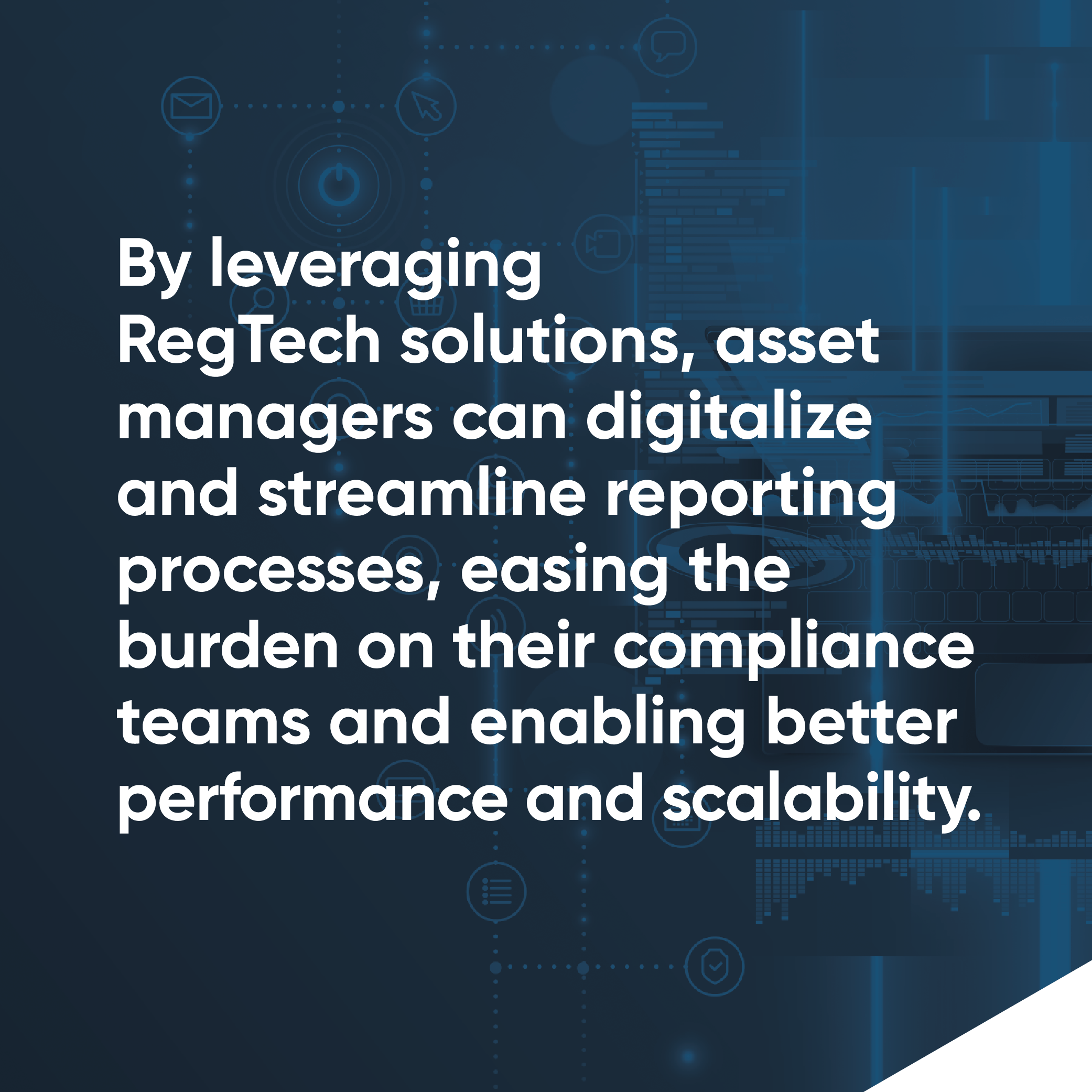It’s no secret that the 2008 financial crisis served as a major turning point for asset managers and in particular their compliance and regulatory oversight teams. Beginning with the passage of the Dodd-Frank Act in 2010, these firms faced a tidal wave of new regulations designed to foster transparency and accountability in the capital markets. This flurry of activity propelled the growth of a relatively new domain: regulatory technology, or RegTech.
 Fast forward to today, the need to remain compliant is more relevant than ever as regulators around the globe continue to beef up reporting requirements. As the space continues to mature, focus is shifting from the what to the how – that is, from simply being compliant to identifying how asset managers and service providers can leverage technology to refine existing compliance and reporting procedures and execute them with efficiency, precision and cost-effectiveness.
Fast forward to today, the need to remain compliant is more relevant than ever as regulators around the globe continue to beef up reporting requirements. As the space continues to mature, focus is shifting from the what to the how – that is, from simply being compliant to identifying how asset managers and service providers can leverage technology to refine existing compliance and reporting procedures and execute them with efficiency, precision and cost-effectiveness.
To do this, the industry needs integrated solutions that streamline processes and standardize actions across the myriad of reports that are now required. Here, we’ll explore some exciting innovations that signify the next phase of RegTech – and how we at Confluence are working to deliver this future.
Manually sifting through massive quantities of data to create standardized reports isn’t a tenable situation. The sheer volume of reporting requirements means errors are inevitable, and data automation is the only solution. By leveraging RegTech solutions, asset managers can digitalize and streamline reporting processes, easing the burden on their compliance teams and enabling better performance and scalability. This kind of straight-through processing enables a higher level of nimbleness and scalability as this era of regulatory uncertainty continues.
The benefits of RegTech solutions are numerous. Automating key processes means that when facing multiple deadlines at once, there is no need for compliance and regulatory teams to double their manhours to complete the reports. And given the benefits of the cloud, processing power can be used to ensure all requirements are being met. For the humans supporting an automated reporting processes, their workflows are revolutionized, and their to-do lists are cleared more easily. Teams also retain full control over the process, so reports can still be filed manually depending on specific needs and areas of expertise.
In addition to automation, consistency of experience is another key development that points the way to the future of RegTech. By integrating compliance and reporting solutions within a wider ecosystem of functionalities, asset managers and service providers can maximize efficiency while minimizing risk.
The sheer number of regulations governing the asset management space necessitates a huge quantity of reports that run the gamut in terms of content, format and timing. By leveraging a platform solution, users can access all RegTech functions in a single location via the same app, making it far easier to manage, and allowing for an overall view of their operations.
It’s not just the RegTech functions that should be centralized in a single location – using them alongside other mission-critical tools makes them even more powerful. For Confluence clients, this means an integrated performance and risk engine that goes far beyond mere regulatory disclosures. Our solution encompasses all risk components, enabling asset managers to supplement disclosures with data and perform compliance monitoring based on derivative threshold testing, bar testing and the like.
The benefits of this consistency of experience go beyond functionality alone – it also reduces risk. Every firm takes its own approach to third-party technology, but one common thread is that when it comes to enlisting vendors, less is more. Integrated solutions with a breadth of capabilities offer simplicity without sacrificing functionality.
The pace of financial regulation has increased markedly over the past decade, but that’s not the only shift that has occurred. Regulators themselves are monitoring the asset management space with an unprecedented level of vigor, making effective reporting even more important. In all regions, regulators are checking the work more closely, and asking asset managers to amend their reports with additional clarifying information. What’s more, there are still a significant number of forthcoming rules on the horizon, including Rule 18f-4 in the United States and a potential AIFMD II in Europe.
At Confluence, helping asset managers navigate disruption is a primary focus, and our RegTech solutions are at the heart of this effort. For three decades, we have played a leading role in helping the industry solve complex investment data challenges, seeing our clients through numerous shifts in the regulatory landscape, and we remain poised to deploy our technology to help them through future disruption.
Our cloud platform is built for speed, scale and efficiency, helping clients achieve dramatic regulatory filing throughput gains via flexible data integration, mapping logic, automation and customizable data validations. With our robust infrastructure and strong track record, clients have confidence in our ability to minimize human error and rapidly respond to regulatory change.
Navigating uncertain regulatory waters is no easy task, but identifying the right RegTech partner can make all the difference in the world. By prioritizing automation and integration, asset managers and service providers can position themselves for the future of compliance – no matter what that looks like.
{{cta(‘b93ad1ca-160e-418d-9b4e-aeddd42789ef’)}}
Disclaimer: The information contained in this communication is for informational purposes only. Confluence/StatPro is not providing, legal, financial, accounting, compliance or other similar services or advice through this communication. Recipients of this communication are responsible for understanding the regulatory and legal requirements applicable to their business.